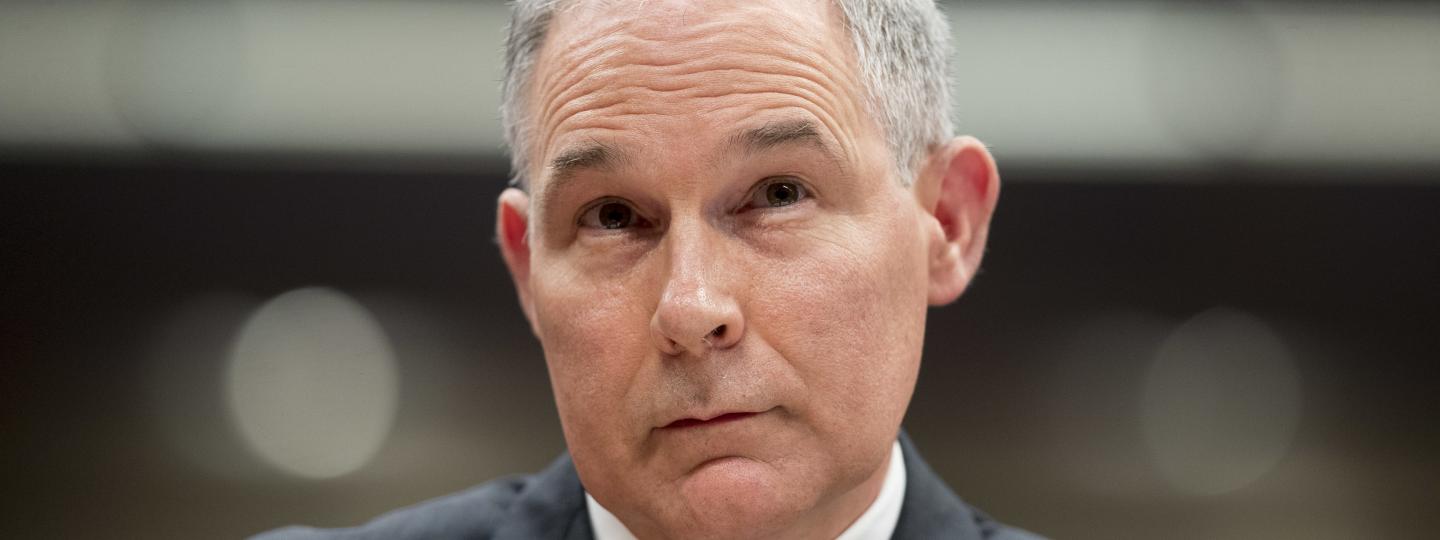In the past two days, the Environmental Protection Agency barred some reporters — perhaps illegally — from a summit on toxic chemicals linked to cancer, allegedly shoving an AP reporter out the door when she asked to see a press officer and started filming threats from security guards on her phone. The incident cast anew a spotlight on the Trump administration’s hostility to the media, raising troubling questions about transparency and retaliation for critical coverage.
It’s bad enough that taxpayer-paid officials blocked members of the press from doing their primary job in a democracy: being the public’s eyes and ears on government actions. What’s even worse is that unfair treatment of the press happens a lot in Washington — under Democratic and Republican administrations.
When the EPA blocked reporters from AP, E&E (Energy & Environment) News and CNN from attending a Tuesday morning address by Administrator Scott Pruitt on dangerous chemicals in U.S. drinking water, the agency was following a bipartisan tradition of seeking to control the press by controlling access. Sadly, it’s not new for press officers to punish organizations for unflattering coverage while bestowing goodies like restricted seats and exclusive briefings on those deemed friendly or most influential. I saw it under Presidents Obama and Bush – and it’s been happening for as long anyone in Washington remembers.
An important difference now is context and the contagion effect. Past presidents didn’t relentlessly try to undermine faith in the press as “fake news;” Donald Trump’s demonizing of journalists as “the enemy of the people” has emboldened national, state and local officials to defy open meetings and open records laws, and in some cases, threaten or attack journalists, said Peter Sterne, who runs the U.S. Press Freedom Tracker, which was created last year to monitor violence, arrests and legal action against U.S. reporters.
The EPA’s botched media blackout lays in stark relief. Here are some important takeaways:
It’s the law, stupid. EPA officials arguably violated the law when they barred any press from the second day of a summit with industry and environmental representatives on what to do about toxic chemicals in drinking water.
The Federal Advisory Committee Act requires that any advisory group making recommendations to the federal government “shall be open to the public.” Journalists protect their interests if they’re versed in open records and open meetings laws. David Beard, co-author of Poynter’s media newswire, advises carrying a copy of relevant laws in your wallet, ready to pull it out and challenge any official who tries to shut the door on you. Have good communication with your editor (and company lawyer, if you’re lucky to have one) so you can raise objections immediately if officials try to stymie you.
Shutting out the press comes back to bite those who do it. Ironically, the EPA might well have enjoyed positive press coverage of steps announced to address concerns over chemicals in drinking water. Instead, the fracas over the mistreatment of reporters overshadowed news of the event itself, becoming the latest controversy to dog the EPA’s Pruitt.
Pruitt has gotten intense press scrutiny over his sweetheart rent deal from a lobbyist, his lavish spending of taxpayer funds for travel, security and amenities, and his lucrative ties to the energy industry; he is the subject of at least 12 federal investigations as a result of accountability reporting the EPA has tried so hard to block. His pitbull press team has sought to aggressively shield him from the press, has kept secret his schedule and whereabouts, and took the extremely unusual step of blacklisting an AP reporter whose coverage they don’t like, denouncing him in a government press release and removing him from a press email list. That bare-knuckled approach hasn’t caused reporters to pull their punches, and it certainly hasn’t stemmed the tide of unflattering stories.
It’s not fair, but officials don’t treat all press equally. An uncomfortable truth of Washington journalism is that there’s a hierarchy – a pecking order in the White House and State Department briefing rooms, the Senate press gallery and beyond. The leading national newspapers, wire services and network and cable TV sit at the top of the heap, snagging front-row seats and the first questions at every briefing, while regional, speciality and startup news outlets have to jockey for sources, interviews, limited seats on government planes and summits like this week’s at the EPA. It’s a dog-eat-dog world where there are big dogs, mid-sized dogs and runts fighting for attention.
I covered the 2008 presidential campaign and the State Department throughout the Obama administration for Bloomberg News, and for the most part, I reaped the benefits of representing a major wire service: good seats in the briefing room, a spot on most trips and pool rotations, and timely responses to emails and phone calls. But I also felt the sting of frustration when officials would grant access to a restricted event, briefing, or interview to just The New York Times or a prominent TV anchor, leaving the rest of us fuming and lodging complaints that fell on deaf ears. It was a motivator, of course, for everyone to cultivate their best sources in the administration who would share information even if we weren’t the ones on the list for approved leaks – and some of the best stories came from that persistence and shoe leather.
Planning and persistence pay off. Have a backup plan, and don’t take no for an answer (unless someone’s safety is at risk). The EPA doled out 10 press seats for the Tuesday morning summit opening, claiming there was no room for more. Knowing he didn’t have a seat, E&E News reporter Corbin Hiar contacted officials who’d be in the room and arranged for them to brief him after. It’s never the same to watch an event on livestream because you don’t have access to sources in the room, so Hiar and others came anyway to try their luck in person.
There were no-shows among the “approved” press, but their seats were never reassigned. Hiar made a fuss. “I stood around, I didn’t leave, I waited till they gave me an answer and when I didn’t like that answer, I said ‘C’mon on, can I at least talk to someone later?’” It worked; he was granted an official interview.
The flurry of press reports on the AP reporter being grabbed by security unexpectedly prompted the agency to open the afternoon session, and those reporters who stuck around were allowed to enter. Persistence paid off.
The loosening of restrictions was short-lived. Wednesday morning, the EPA closed the second day of the summit to the press, turning away those who showed up: E&E, Politico, and an environmental journalist/author.
Journalists must speak out about threats to press freedom. At worst, the EPA debacle was a move to block public access to information and decisions that affect health and safety of all Americans. At best, it was a ham-handed effort to penalize outlets for unfavorable coverage or discriminate against others with special expertise. Either way, we can’t just dismiss it.
AP executive editor Sally Buzbee called the EPA’s actions “alarming, and a direct threat to the public’s right to know about what is happening inside their government.”
CNN’s statement said, “We understand the importance of an open and free press and we hope the EPA does, too.”
E&E executive editor Cy Zaneski told me he can’t tell if it’s “chaos or conspiracy.” It would behoove the EPA’s and the public “to have reporters like ours in the room who have a great deal of experience covering these issues,” he said.
Barbara Cochran, president of the National Press Club Journalism Institute, said “it should go without saying that the press must be able to cover public events convened by a taxpayer-funded government agency.” And the National Press Club has responded with plans for a summit between newsmakers and media to defuse tensions.
Officials need to keep their hands off reporters – and we must raise objections when they don’t. It’s not just the AP’s Ellen Knickmeyer who was shoved by security. Remember Greg Gianforte, the Montana GOP candidate for Congress who body-slammed a Guardian reporter last year and was elected anyway? Or CQ Roll Call’s John Donnelly, who was pinned to the wall by security guards and forced out of the building when he tried to question an FCC commissioner last year? Or then-Trump campaign manager Corey Lewandowski, who grabbed a reporter and nearly knocked her down? Since last year, reporters have been roughed up from Alaska to West Virginia.
“Document it when it happens. Tell your editor, lawyer and the public. When there’s an issue of government infringing on your right to inform the public, that is a story and don’t be afraid to tell that story,” said Sterne of the Freedom of the Press Foundation.
The Committee to Protect Journalists and Reporters Committee for Freedom of the Press offer legal resources for reporters needing assistance.
Band together with other news organizations; there’s power in numbers. At the White House, State Department, Pentagon and Congress, strong correspondents’ associations advocate on behalf of the collective press corps on issues related to briefings, access, and ground rules for interviews. EPA reporters don't have their own in-house correspondents' association to apply collective pressure or a pool system to share reporting when the agency wants to limit access. That’s a disadvantage that could be easily remedied.
One option might be to create an EPA-reporters-only offshoot of the Society of Environmental Journalists, which represents 1,400 members across North America and 27 other countries. SEJ president Bobby Magill, a Bloomberg Environment reporter, sent a letter to the EPA protesting the selective blackout yesterday, calling the agency's claims that there wasn't enough space "patently ridiculous. Surely, larger rooms were available at the EPA headquarters or in a nearby federal building or hotel."
Matt Daily, energy editor at Politico, told me his news organization is regularly in touch with EPA officials, pressing for better access “to information and meetings that we believe are in the public interest.” At first, EPA officials weren’t granting any access to the toxic chemicals summit. After sustained pressure from Politico and perhaps others, the agency agreed to allow a select group in. Imagine how much stronger the pressure would be if it came from every news organization that covers the EPA?
What matters most are standards and quality of your reporting. In a perverse way, Donald Trump’s vitriolic campaign to brand news as “fake” has breathed new life into accountability journalism and forced journalists to bolster best practices and quality reporting.
“Now we have to go back to the basics – not just talk to spokespeople. We ask reporters how many officials did they talk to, how do they know what they know?” Daily said. “There are no shortcuts to navigating good stories; you have to be well-sourced and an expert in your subject matter because there's a lot of scrutiny on us now, and I think that’s proper. And we’ve done more and better coverage of the EPA than ever before.”
Clarification: EPA reporters don't have a correspondents association, but a protest letter was sent to the EPA yesterday by the Society of Environmental Journalists, which represents 1,400 members around the world. The story has been updated to include the letter.
Disclosure: Poynter has trained or will be training journalists from nearly all the news outlets that attended or were excluded from the EPA summit.







